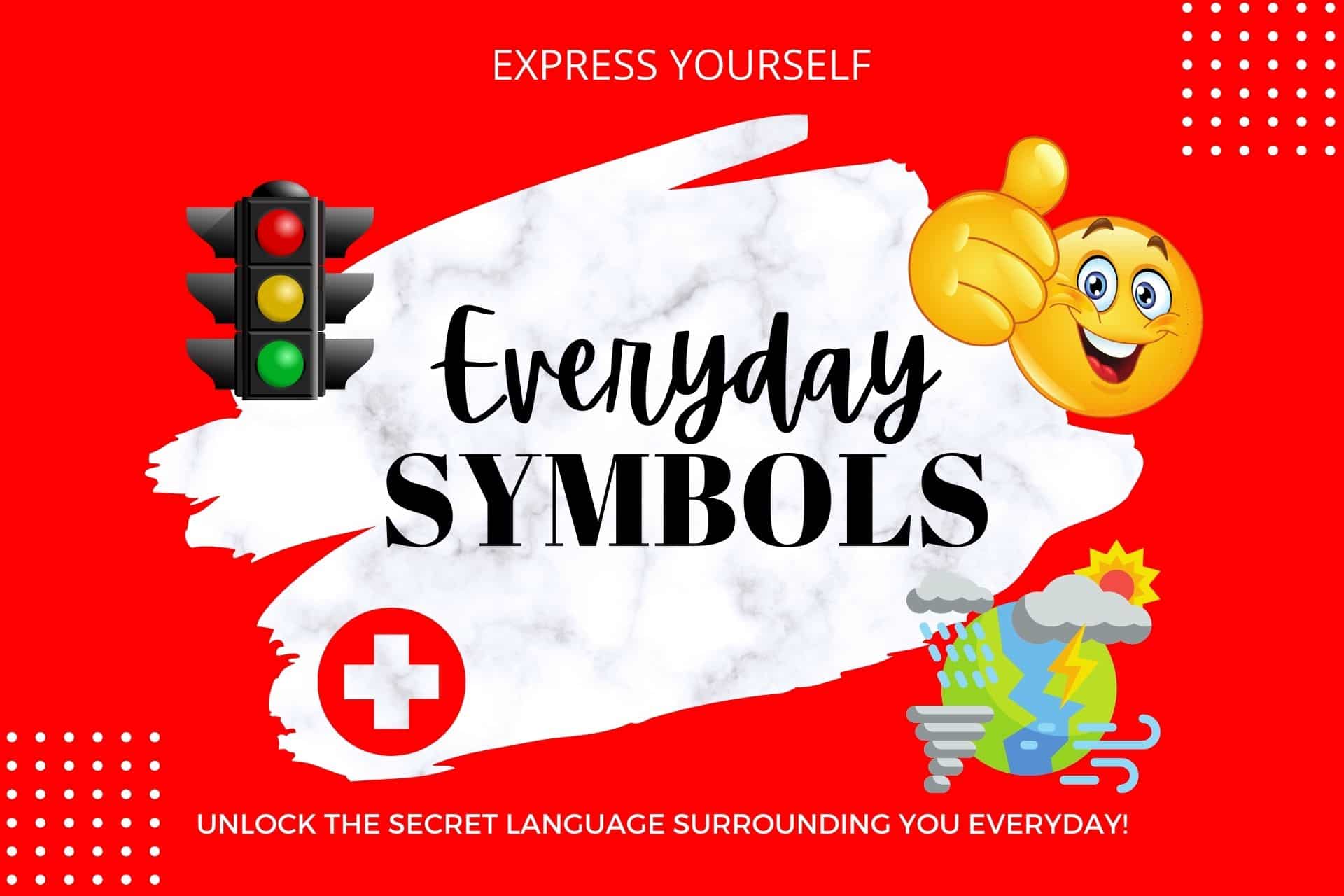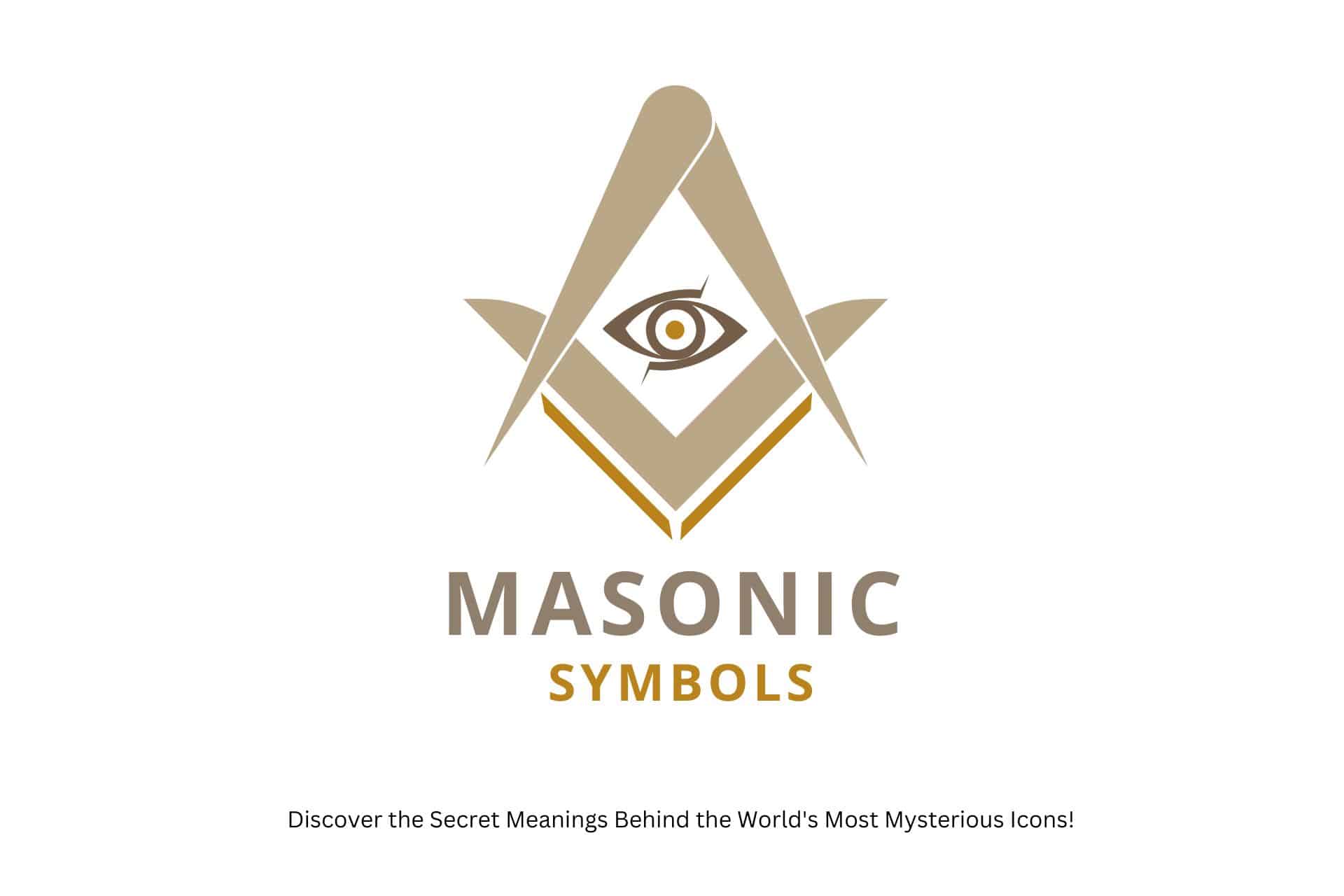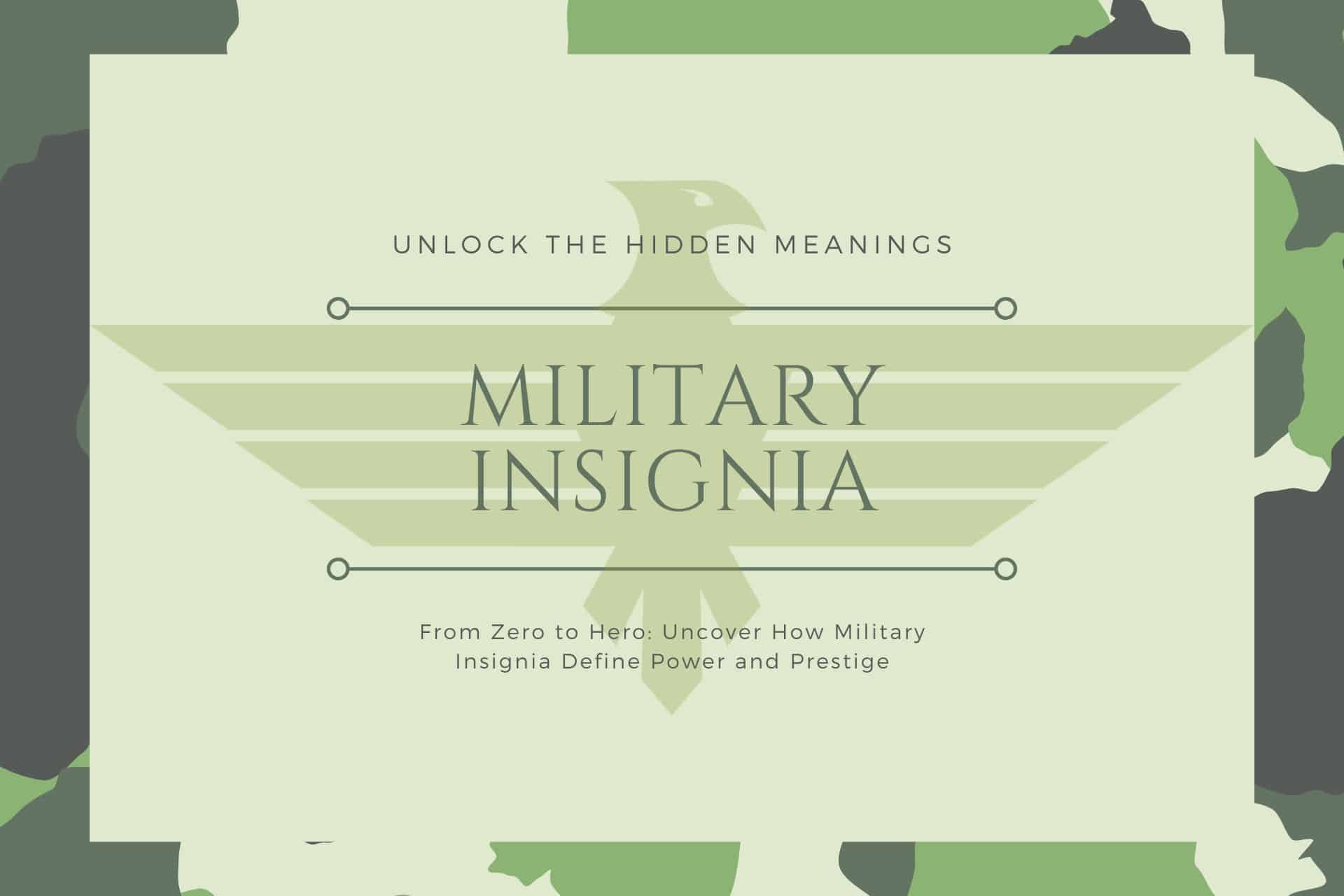You’ll Never Look at Street Signs the Same Way Again: The Hidden Meanings Behind Common Symbols and their Meanings!
Are you puzzled over the everyday symbols that pepper our daily landscape, from the emojis in our texts to the signs that guide us on roads and through public spaces?
This article is your gateway to understanding the rich tapestry of everyday symbols surrounding us. It concisely explores their origins, meanings, and how they connect us across cultures.
Discover the practical knowledge you need to navigate the world of symbols confidently.
Continue reading to unlock the secrets behind these ubiquitous signs and signals, enriching your understanding of the world.
Let’s get started!

Here’s What You Will Find

Key Takeaways
Everyday Symbols
Symbols Are Universal: Across different cultures and contexts, everyday symbols provide a common language that simplifies communication, from weather forecasts to traffic instructions.
Deep Historical Roots: Many symbols, like heraldic icons or medical signs, carry centuries of history, representing complex concepts such as bravery, healing, and authority.
Practical Daily Guidance: Symbols guide our daily decisions, from choosing the right laundry settings to navigating public transportation systems and understanding food packaging.
A Bridge Between Cultures: Embracing and sharing knowledge about symbols can foster understanding and connection across diverse communities, enriching our global perspective.
In our daily lives, symbols serve as a silent language, orchestrating a symphony of interactions and decisions, often without exchanging a single word.
From the moment we wake up to the alerts on our smartphones, represented by tiny icons, to the street signs that guide our journey through the bustling city streets, everyday symbols are omnipresent. They are the unsung heroes of our daily communication, providing a universal language that transcends cultural and linguistic barriers.
Understanding these symbols is not just about navigating the world more smoothly; it’s about connecting with the myriad of messages that shape our daily experiences and decisions. This exploration into the world of daily life and practical use of everyday symbols is not just an academic endeavor but a journey into the heart of our shared human experience.
What Are Everyday Symbols?
Defining the Symbols Around Us
Everyday symbols are the visual signs and icons we encounter regularly in our daily lives that communicate specific meanings or information without the need for words.
From traffic lights guiding our journey to emojis enhancing our digital conversations to recycling logos reminding us of our environmental responsibilities, these everyday symbols form a universal language understood across cultures.
They simplify complex instructions, signify essential warnings, and even express emotions, facilitating smooth and efficient communication in our fast-paced world.
Everyday symbols are the visual shorthand that navigates us through our routines, safety protocols, and interactions. They encapsulate complex information into digestible, universal pictographs or icons, transcending language barriers and simplifying communication.
Symbols as Cultural and Global Connectors
These everyday symbols aren’t just utilitarian; they’re woven into the fabric of our cultures, carrying historical and social significance. From the emojis we use to express emotion in text messages to the religious icons that denote sacred spaces, symbols serve as bridges between diverse cultures, fostering a shared understanding in an increasingly globalized world.
The Language of Efficiency
Everyday Symbols streamline interactions, from guiding us on roads with traffic signs to indicating garment care on clothing labels. This visual language allows quick decision-making and action, crucial in fast-paced environments and emergencies.
Everyday Symbols in Decision-Making
Beyond their practical applications, everyday symbols have a profound psychological impact, influencing our perceptions and decisions. For example, using green for go, red for stop, or a heart to denote health-related information leverages intuitive responses that guide behavior in public spaces, consumer choices, and personal habits.
What is a Symbol in Everyday Life?
A symbol is a recognizable visual mark or icon that conveys a particular meaning or set of ideas without using words. These everyday symbols permeate our daily existence and guide our actions, decisions, and interactions.
From the Wi-Fi icon that connects us to the digital world to the stop sign that ensures our safety on the roads, symbols act as silent communicators. They are the shortcuts in our visual language, enabling quick understanding across different languages and cultures, and are essential for navigating the complexities of modern life.
What is a Common Symbol?
A common symbol is a sign or icon widely recognized and understood within a particular community or society, often beyond linguistic or cultural barriers. These symbols convey specific meanings, ideas, or instructions through simple visual cues.
Examples include the heart symbol representing love, the red cross denoting medical assistance, and traffic lights guiding pedestrian and vehicular movement. Common symbols facilitate communication, promote safety, and succinctly express emotions or concepts, making them integral to daily life and interaction.
Types of Everyday Symbols
Navigating the Visual Language of Common Symbols and Meanings
From Road Safety to Artistic Expression
In the intricate dance of daily life, symbols lead our steps, guiding us through a world rich with visual language. These symbols are more than mere images; they are the universal cues that inform, warn, protect, and communicate across barriers of language and culture.
From the roads we travel to the clothes we wear and the foods we eat, symbols are omnipresent, silently serving as information envoys.
As we explore the daily use of symbols, we uncover the icons that shape our everyday experiences and how they speak their own language, encapsulating complex ideas into simple, recognizable forms.
Let’s examine the symbols we encounter regularly, exploring their significance and roles.
Weather Symbols
Weather symbols bridge complex meteorological data and public understanding, translating forecasts into universally recognizable icons. These symbols encapsulate a range of weather conditions, from sunny skies to impending storms, enabling people to assess the day’s weather at a glance quickly. Their straightforward design allows for immediate recognition and planning, whether deciding to carry an umbrella or wear sunscreen.
Heraldic Symbols
Heraldic symbols are steeped in history, each carrying rich narratives of bravery, heritage, and identity. Traditionally used in coats of arms and family crests, these symbols convey stories of lineage and achievements. The lion, for example, is a widespread symbol of courage and nobility found in numerous national flags and emblems, reflecting its enduring appeal across cultures and epochs.
Clothing and Textile Symbols
Clothing and textile symbols communicate essential care instructions, ensuring garment longevity and proper maintenance. These icons guide consumers on washing, drying, ironing, and caring for different fabrics, safeguarding against damage. These symbols on clothing labels empower consumers with the knowledge to preserve their clothes’ texture, color, and shape.
Food Packaging Symbols
Food packaging symbols play a crucial role in informing consumers about the contents and quality of food products. They address health, dietary preferences, and ethical considerations, marking allergens, nutritional benefits, and certifications like organic or fair-trade. This information helps consumers make choices aligned with their health needs and values, fostering transparency and trust between producers and consumers.
Artistic Symbols
Artistic symbols are tools artists use to imbue their work with deeper meanings. They transcend the literal to evoke emotions and provoke thought. Whether traditional or novel, these symbols enrich narratives and connect viewers to broader themes and personal introspections, making art a universal language of human experience.
Emojis
Emojis have revolutionized digital communication, adding emotional depth and nuance to text-based interactions. These vibrant icons capture a wide spectrum of human emotions and activities, enabling users to express feelings and concepts succinctly and vividly, enriching the digital dialogue.
Public Transportation Icons
Public transportation icons streamline the travel experience, providing clear, concise guidance through complex transit networks. These symbols, standardized across many systems, assist travelers in navigating routes, identifying services, and accessing facilities, making public transportation more accessible and user-friendly.
Medical Symbols
Medical symbols are critical in identifying healthcare services, professionals, and resources. They convey trust, care, and expertise and guide individuals needing medical attention. Symbols like the Rod of Asclepius represent the healing arts and embody the medical profession’s commitment to health and healing.
Safety Symbols
Safety symbols are vital in preventing accidents and ensuring well-being across various environments. They alert individuals to potential hazards and provide instructions for safe practices, contributing to a culture of safety and awareness.
Recycling Symbols
Recycling symbols are key components of environmental conservation efforts. They guide the proper disposal and recycling of materials, encourage sustainable practices by helping individuals identify recyclable items, and help them understand recycling processes. Recycling symbols play a significant role in waste management and environmental protection.
Access Symbols
Access symbols advocate for inclusivity, highlighting features and services accommodating individuals with disabilities. They promote equal access to and participation in public life and reflect a commitment to diversity and inclusion.
Information Technology Symbols
Information technology symbols facilitate interaction with digital devices and platforms, guiding users through interfaces and functionalities. These icons are integral to the usability of technology, making digital tools more intuitive and accessible.
Sport Symbols
Sports symbols represent various athletic disciplines, promoting recognition and enthusiasm for sports. Used in venues, merchandise, and international competitions, they celebrate athletic achievements and foster a sense of community among fans and athletes alike.
Currency Symbols
Currency symbols are essential in global commerce. They denote the type of currency in financial transactions. They provide clarity in pricing, billing, and economic analysis, supporting the smooth operation of the global economy.
Legal Symbols
Legal symbols denote intellectual property, rights, and judicial concepts within legal contexts. They serve as shorthand for complex legal principles and facilitate clear and efficient communication in legal documents and discussions.
Energy and Power Symbols
Energy and power symbols identify sources of energy and control settings on devices. They are crucial in operating and understanding electrical and electronic equipment. These symbols guide users in managing energy use and power options, ensuring safety and efficiency.
Chemical Symbols
Chemical symbols represent elements and compounds in the scientific discipline of chemistry. They provide a universal language for exploring and communicating chemical properties and reactions, and they are fundamental to studying and applying chemistry in various fields.
Astronomical and Astrological Symbols
Astronomical and astrological symbols denote celestial bodies and astrological signs, bridging science and symbolism. They facilitate studying the cosmos and exploring astrological influences, reflecting humanity’s fascination with the stars.
Geometric Shapes
Geometric shapes symbolize different concepts and principles across diverse contexts, from education to design. They form the foundation of visual literacy, aiding in comprehending and creating visual information.
Sign Language Symbols
Sign language symbols represent the visual communication system used by deaf and hard-of-hearing individuals. These pictorial representations of sign language gestures enable the documentation and learning of sign languages, promoting accessibility and inclusion.
Political Symbols
Political symbols embody the ideals, movements, and identities of political entities and ideologies. They rally support, foster solidarity, and provoke discussion, and they play a significant role in the democratic process and the expression of political beliefs.
Each category adds to the rich lexicon of symbols we encounter daily, providing a framework for understanding the complex and multifaceted world around us. These symbols bridge languages and cultures, offering a universal means of communication across diverse domains of life.
What Are Everyday Symbols?
Defining the Symbols Around Us
Everyday symbols are the visual shorthand that navigates us through our routines, safety protocols, and interactions. They encapsulate complex information into digestible, universal pictographs or icons, transcending language barriers and simplifying communication.
Symbols as Cultural and Global Connectors
These everyday symbols aren’t just utilitarian; they’re woven into the fabric of our cultures, carrying historical and social significance. From the emojis we use to express emotion in text messages to the religious icons that denote sacred spaces, symbols serve as bridges between diverse cultures, fostering a shared understanding in an increasingly globalized world.
The Language of Efficiency
Everyday Symbols streamline interactions, from guiding us on roads with traffic signs to indicating garment care on clothing labels. This visual language allows quick decision-making and actions, which is crucial in fast-paced environments and emergencies.
Symbols in Decision-Making
Beyond their practical applications, symbols have a profound psychological impact, influencing our perceptions and decisions. Using green for go, red for stop, or a heart to denote health-related information leverages intuitive responses that guide behavior in public spaces, consumer choices, and personal habits.
The Significance of Understanding Everyday Symbols
Enhancing Daily Navigation
Symbol literacy enhances our ability to navigate daily life more easily and confidently. Understanding the meaning behind traffic signs, safety symbols, and even digital icons on our devices empowers us to make informed decisions, ensuring our safety and the well-being of others.
Fostering Cultural and Global Connections
Everyday Symbols act as cultural touchstones, offering insights into societies’ values, traditions, and history. Learning about the significant symbols in different cultures deepens our global awareness and empathy and promotes cross-cultural understanding and respect.
The Power of Shared Knowledge
Encouraging the sharing of symbolic knowledge enriches our collective understanding and appreciation of the world. Whether explaining the significance of a local monument’s symbols to visitors or sharing the latest digital icons with less tech-savvy friends, spreading symbol literacy connects us through shared learning and experiences.
Understanding daily life and the practical use of symbols equips us with the tools for more effective communication, opens doors to deeper cultural connections, and raises global awareness. This shared visual language is a testament to human creativity and our innate need for connection and understanding.
Symbols in Everyday Communication
Symbols serve as the cornerstone of our daily interactions, enhancing the efficiency and clarity of our communications in ways that words alone cannot. By distilling complex ideas into simple visuals, they bridge linguistic and cultural divides, making information universally accessible.
Enhancing Communication Efficiency and Clarity
Symbols cut through the clutter of lengthy explanations, providing instant comprehension. For example, road signs quickly convey rules and warnings to drivers from all linguistic backgrounds, reducing the need for lengthy textual instructions and increasing road safety and efficiency.
Psychological Impact on Behavior and Decision-Making
The power of symbols extends into psychology, where they can influence behaviors and decision-making processes. With its three arrows in a loop, the recycling symbol has become a global emblem for sustainability efforts, prompting individuals and communities to adopt more environmentally friendly practices.
Symbols as Catalysts for Change
Symbols have the potential to initiate societal changes by communicating complex messages succinctly. The pink ribbon, for instance, has raised widespread awareness and support for breast cancer research, demonstrating how symbols can mobilize communities around a cause.
The Value of Symbol Literacy in Our Lives
Understanding the symbols that permeate our daily existence is more than an academic pursuit—it’s a practical skill with real-world applications. Symbol literacy enhances our ability to navigate the world, connect with diverse cultures, and share knowledge across boundaries.
Navigating Daily Life with Symbol Literacy
Symbol literacy empowers us to interpret and interact with the myriad of symbols we encounter daily, from following safety instructions to using technology. It enables us to make informed decisions, whether choosing eco-friendly products or understanding public transport routes.
Bridging Cultural and Global Connections
Symbols are a universal language that transcends national borders and linguistic barriers. Understanding symbols can help us gain insights into different cultures and historical contexts, fostering global awareness and empathy. Recognizing religious symbols can enhance our respect for and understanding of diverse faiths and practices.
Sharing Knowledge and Fostering Community
Encouraging the sharing of symbolic knowledge spreads awareness and strengthens community bonds. Educating others about symbols’ meanings and importance, such as those related to public health or environmental conservation, can lead to collective action and societal improvement.
In essence, symbols are vital components of our daily communications. They are imbued with the power to convey complex messages succinctly, influence behaviors, and foster connections across the globe. Understanding these symbols is crucial for navigating the modern world, enhancing our interactions, and contributing to a more informed and cohesive society.
FAQs: Answering Your Questions
What is an example of symbolism everyday?
An everyday example of symbolism is using a green light at traffic signals. In many cultures, a green light symbolizes “go” or “proceed,” directing traffic flow efficiently and safely. This simple color-coded system transcends language barriers, offering a universal method of communication that relies on color symbolism to convey critical information quickly and clearly.
Can the meaning of symbols change over time?
Absolutely. Just as languages evolve, so do symbols’ meanings. What may have started as a symbol with one specific meaning can acquire new layers or even completely change over time due to cultural shifts, technological advances, or changes in societal values.
Does everyone around the world understand any universal symbols?
While no symbol is truly universal due to cultural variations, some symbols come close due to global standardization. For example, traffic signs like the “stop” sign and basic symbols like the power button on electronic devices are widely recognized across cultures.
How can I learn more about the symbols I encounter in daily life?
Curiosity is your best tool. Search for symbols that intrigue you, visit libraries or museums, and use credible online resources. Many books and guides are also dedicated to the history and meaning of symbols in various fields.
Why are some symbols considered controversial?
Symbols can carry deep historical, political, or cultural meanings. When symbols are used outside of their original context or by groups with different ideologies, they can become sources of controversy. Understanding the background and evolution of a symbol can shed light on its contentious nature.
How can I teach children about the importance of symbols?
Start with symbols in their everyday environment, like road signs or symbols on household products. Encourage questions and explore the meanings together. Interactive learning, such as drawing or finding symbols in a scavenger hunt, can make learning fun and memorable.
Last Thoughts
As we’ve journeyed through the diverse world of everyday symbols, it’s clear that these symbols form a silent symphony, orchestrating our interactions with the world and each other. From the emojis that add flavor to our digital conversations to the traffic signs that guide us safely on our travels, symbols enrich our lives with meaning, safety, and efficiency.
Understanding these symbols is not just about navigating the physical world; it’s about connecting with the rich tapestry of human culture and history. Each symbol carries a story, a legacy of human ingenuity and collaboration across time and space. By diving into the meanings behind these symbols, we unlock new layers of understanding about our world and ourselves.
So, the next time you encounter a symbol, whether on a clothing label, a food package, or a street corner, take a moment to appreciate the complex web of meaning it represents. Share your knowledge with others, sparking curiosity and conversation. In this way, we can all contribute to a deeper, shared understanding of the symbols that shape our daily lives.
And who knows? Perhaps sharing the stories behind these symbols will provide more than just information. We might discover new connections, laughter, and a renewed sense of wonder. After all, isn’t that what symbols are all about?
Before You Go
If you’ve found this journey through the world of symbols as enlightening as we hope, don’t keep it to yourself! Sharing this knowledge can spark fascinating conversations, deepen connections, and spread awareness about the rich symbolism that shapes our daily experiences.
Whether through social media, email, or a casual chat over coffee, passing on what you’ve learned can help others navigate and appreciate the symbols in their lives.
So, go ahead—share the insights and let the symbols do the talking!
More on Everyday Symbols
- Weather Symbols:
- Heraldic Symbols:
- Clothing and Textile Symbols:
- Food Packaging Symbols:
- Artistic Symbols:
- Emojis:
- Public Transportation Icons:
- Medical Symbols.
- Safety Symbols:
- Recycling Symbols:
- Access Symbols:
- Information Technology Symbols:
- Sport Symbols:
- Currency Symbols:
- Legal Symbols:
- Energy and Power Symbols:
- Chemical Symbols:
- Astronomical and Astrological Symbols:
- Geometric Shapes:
- Sign Language Symbols:
- Political Symbols:
More on Symbols
History of Symbols: How Ancient Marks Shape Our Modern World!
From Cave Walls to Emojis—A Journey Through Time Have you ever wondered about the history of symbols? Maybe you’ve wondered about their global variations or how they’ve shaped our world. Prepare to have your curiosity …
Check it Out!Tattoos and Their Secret Powers: How Ink Can Change Your Life!
Exploring the Art, Meaning, and Culture of Ink! Are you intrigued by tattoos? Are you curious about the stories they tell and the intricate details they contain? Look no further. You might be wondering about …
Check it Out!Masonic Symbols Unlocked: Discover the Secret Meanings Behind the World’s Most Mysterious Icons!
The Hidden Powers and Ancient Secrets You Never Knew! Are you intrigued by masonic symbols and their profound meanings? Perhaps you’ve seen the square, compasses, or the all-seeing eye and wondered about their significance? Thankfully, …
Check it Out!Military Insignia: Unlock the Hidden Meanings Behind These Powerful Symbols
From Zero to Hero: Uncover How Military Insignia Define Power and Prestige Are you curious about the meaning behind military insignia or rank emblems? Have you ever wondered about their significance or history? This comprehensive …
Check it Out!More Symbols

















